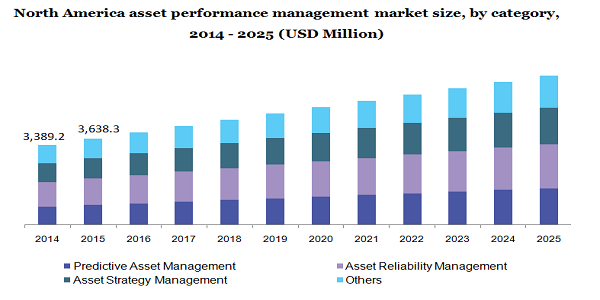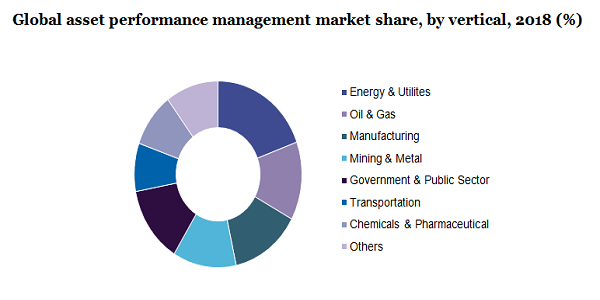- US: +1-408-610-2300
- Toll Free: +1-866-831-4085
- Become a Client
The global asset performance management market size was accounted for USD 13,237.85 million in 2018 and is projected to grow at the CAGR of 9.15% over the forecast period, 2019 to 2025. Increasing demand for digital platforms or solutions to maintain the performance of physical assets such as heavy equipment and machinery through data analytics is projected to spur the demand for asset performance management solutions. It includes various sectors such as manufacturing, chemical, oil & gas, and others. This helps to track operational assets in the industrial units. These solutions also allow prioritizing of operations. All these key benefits are projected to propel market growth.
Performance asset management solutions can be integrated with software and services which helps in tracking the reliability and health of the assets. These systems give informed decisions to users whether if there is a need for divestment or other operation. The asset management system provides reduced downtime, low maintenance cost, and equipment failure risk. For example, General Electric offers APM Reliability, APM Health, APM Integrity, and APM Strategy. These software tools help companies to improve the efficiency and productivity of their assets.

An asset management system helps manufacturers to address the problems such as environmental risks, rising operational costs, labor risks, and decision making. Moreover, the growing trend of digital performance management systems with the integration of the Industrial Internet of Things (IIoT) is gaining popularity. The IIoT solutions help to increase the reliability of the equipment. Furthermore, integrations of these systems with geographical information systems (GIS) and mobile solutions increase the efficiency of operational assets, which are projected to surge the market growth.
The growing adoption of digital twin technologies is also expected to increase the demand for asset management solutions. Digital twin provides digital analysis of systems and machinery. This technology analyzes the harmful and critical operating conditions through simulation, which helps to avoid damages to equipment or assets.
The asset performance management market is divided into hosted and on-premises depending on deployment modes. The hosted segment is comprised of private and public clouds. In 2018, on-premises deployment attributed to over 50.0% market share in the overall market. On-premise systems are more preferred due to their customization. In this deployment type, equipment, and machines installed at manufacturing units require customized system support. In the case of cloud-type segments, security and safety measures need to be managed, hence the on-premise system is gaining in popularity.
However, development in security measures is attracting consumers to look for cloud-based solutions. In gas & oil, and chemical industries cloud-based systems are highly deployed as the companies seek for expanding their product portfolio. Hosted type deployment is anticipated to propel at the CAGR of around 11.49% over the forecasted period. These systems require less infrastructural resources, can be easily upgraded, and are also available at affordable costs. Private cloud systems are projected to grow at a significant rate, and over 60.0% of consumers favor public cloud systems.
The market is divided into asset strategy management, asset reliability management, and predictive asset management, and others. In 2018, the asset reliability management segment held the highest market share in the overall market. This asset management solution helps to maintain the reliability of equipment and machinery in the operational units. It also addresses if there is any risk of equipment failure. Thus, due to these key factors industry operators are opting for asset reliability systems.
Predictive asset management solutions are anticipated to grow at the fastest CAGR of over 11.0% from 2019 to 2025. These solutions include different processes and operational computing tools such as neural networks, analysis tools, statistical tools, algorithms, and machine learning. These processes and tools provide safety and preventive measures to avoid failure in asset management. These operational benefits are influencing companies to utilize these solutions.
Asset management solutions are widely used in different verticals such as manufacturing, transportations, government & public sector, mining & metal, energy & utilities, oil and gas, and pharmaceuticals & chemicals. In 2018, the energy and utility sector dominated the market, owing to the rising consumption of gas and electricity. In addition, the growing trend of solar power and wind projects is supporting the segmental growth.

Public and government segment is projected to register a CAGR of over 10.7% during the forecasted period. An increasing number of projects in wastewater treatment across the countries such as Mexico, Brazil, and Malaysia is contributing to market growth. The manufacturing segment is anticipated to expand at a CAGR of over 10.0% over the forecasted period. The Asia Pacific is estimated to be a key contributor to this segmental growth.
In 2018, North America held the major share of over 30.0% in the overall market. The increasing number of R&D activities in IIoT technology is mainly attributed to the rising demand for asset management solutions.
Europe is projected to grow at a significant CAGR, during the forecasted period. Growing demand for the asset tracking solution and growing focus on digital transformation across countries such as Germany and the U.K. are driving regional growth. Asia Pacific is projected to expand at the CAGR of 10.11% over the forecasted period. This growth is constituted by high demand from the growing industrial sector especially in countries like India, South Korea, and China.
COVID-19 has opened multifaceted challenges to asset performance management across various industries such as infrastructure, real estate, manufacturing, and other sectors. The transportation sector is facing a huge impact due to the loss of revenues. Thus, asset management is now becoming critical during pandemic situations, as carrying out capital maintenance, repair when the asset's utility is low.
Various factors such as reduced productivity, and supply chain disruption are affecting the growth of the industry. However, rising cyber security concerns and the growing need for risk mitigation are projected to positively impact market growth.
Leading players in the market include ARMS Reliability; Aspen Technology Inc.; ABB; Bentley Systems Incorporated; IBM Corporation; and General Electric.
Key players in the market collaborate with technology providers to provide advanced solutions using machine learning, artificial intelligence (AI), virtual reality, and augmented reality. Additionally, they engage in new product launches, strategic partnerships to remain competitive in the industry.
|
Attribute |
Details |
|
The market size value in 2020 |
USD 15,800.0 million |
|
The revenue forecast in 2025 |
USD 24,401.62 million |
|
Growth Rate |
CAGR of 9.15% from 2019 to 2025 |
|
The base year for estimation |
2018 |
|
Actual estimates/Historical data |
2014 - 2017 |
|
Forecast period |
2019 - 2025 |
|
Quantitative Units |
Revenue in USD Million & CAGR from 2019 to 2025 |
|
Report coverage |
Revenue forecast, company ranking, competitive landscape, growth factors, and trends |
|
Segments covered |
Deployment mode, category, vertical, region |
|
Regional scope |
North America, Europe, Asia Pacific, South America, and Middle East & Africa. |
|
Country scope |
U.S., Canada, U.K., Germany, France, China, Japan, India, Mexico, and Brazil. |
|
Key companies profiled |
ABB; ARMS Reliability; Aspen Technology Inc.; Bentley Systems Incorporated; General Electric; IBM Corporation. |
|
Customization scope |
Free report customization (equivalent to up to 8 analysts working days) with purchase. Addition or alteration to country, regional & segment scope. |
|
Pricing and purchase options |
Avail of customized purchase options to meet your exact research needs. |
This report forecasts revenue growth at global, regional, and country levels and provides an analysis of the latest industry trends and opportunities in each of the sub-segments from 2014 to 2025. For the purpose of this study, Million Insights has segmented the global asset performance management market report on the basis of deployment model, category, vertical, and region:
• Deployment Mode Outlook (Revenue, USD Million, 2014 - 2025)
• On-Premises
• Hosted
• Public Cloud
• Private Cloud
• Category Outlook (Revenue, USD Million, 2014 - 2025)
• Predictive Asset Management
• Asset Reliability Management
• Asset Strategy Management
• Others
• Vertical Outlook (Revenue, USD Million, 2014 - 2025)
• Energy & Utilities
• Oil & Gas
• Manufacturing
• Mining & Metal
• Government & Public Sector
• Transportation
• Chemicals & Pharmaceuticals
• Others
• Regional Outlook (Revenue, USD Million, 2014 - 2025)
• North America
• U.S.
• Canada
• Mexico
• Europe
• U.K.
• Germany
• France
• the Asia Pacific
• China
• Japan
• India
• South America
• Brazil
• Middle East & Africa (MEA)


Research Support Specialist, USA